Anchor plate
An anchor plate, floor plate[1] or wall washer is a large plate or washer connected to a tie rod or bolt. Anchor plates are used on exterior walls of masonry buildings, for structural reinforcement. Being visible, many anchor plates are made in a style that is decorative.[2]
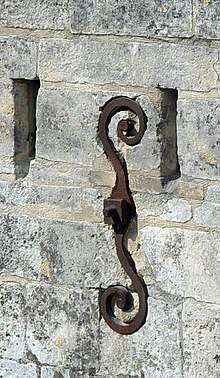
One popular style is the star anchor—an anchor plate cast or wrought in the shape of a five-pointed star. Other names and styles of anchor plate include earthquake washer, triangular washer, S-iron, and T-head.[2] In the United Kingdom, pattress plate is the term for circular restraints,[3] tie bar being an alternate term for rectangular restraints.
Anchor plates are made of cast iron, sometimes wrought iron or steel, and are often used on brick or other masonry-based buildings. They are commonly found in many older cities, towns and villages in Europe and in more recent cities with substantial legacies of 18th- and 19th-century brick construction, such as New York, Philadelphia, St. Louis, Cincinnati and Charleston, South Carolina, and in older earthquake prone cities such as San Francisco, as well as across all of Europe. The tie-rod-and-plate assembly braces the masonry wall against lateral bowing.
Definition
According to the Oxford Dictionary of Construction, Surveying and Civil Engineering, an anchor plate "is a plate attached to a component that enables other components to be connected to it."[1]
Although there are many types of anchors or anchorages, according to the Dictionary of Architecture and Construction, an anchor plate specifically is a "wrought-iron clamp, of Flemish origin, on the exterior side of a brick building wall that is connected to the opposite wall by a steel tie-rod to prevent the two walls from spreading apart; these clamps were often in the shape of numerals indicating the year of construction, or letters representing the owner's initials, or were simply fanciful designs." [4]
While most types of anchors are made of only steel, anchor plates might also contain malleable or cast iron. The exterior wall washer is most often made of a cast-iron star or a flat steel plate.[5]
History of use and studies
In Roman technology, wooden tie-beams (or tie rods) were used between arches to negate the outward horizontal forces between them.[6]
In the modern era, tie-rods are made of iron or steel, and serve to reinforce vaults, arches, and in general masonry structures. Reinforced masonry walls are strengthened through a tie-rod that connects between parallel walls at the floor-level, which creates a horizontal compression state, thereby increasing the wall's shear strength.[6] While the current literature is very poor, some studies have been done on analysis of anchor plates and tie-rods, for example one study dealing with concrete panels, which, although a thin veneer, may also need anchor plates to help stabilize the wall.[7]
The pressure that an anchor plate provides is constantly stiff. A study found that, as widths exceed 100 millimetres (3.9 in), the advantage of having a wider plate decreased, indicating a width threshold for optimal support.[6]
Gallery
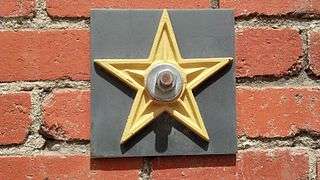 On a building in Petaluma, California
On a building in Petaluma, California- Tie rods and anchor plates in the ruins of Coventry Cathedral
 Anchor plate on a church in North Rhine-Westphalia
Anchor plate on a church in North Rhine-Westphalia_Wohlenb%C3%BCttel_-_Wasserm%C3%BChle_05_ies.jpg) X-shaped wall anchor in Lower Saxony
X-shaped wall anchor in Lower Saxony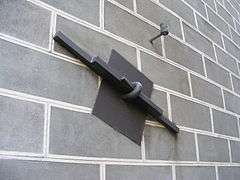 Bar-style wall anchor in Florence
Bar-style wall anchor in Florence.jpg) A star-shaped anchor plate in New York City
A star-shaped anchor plate in New York City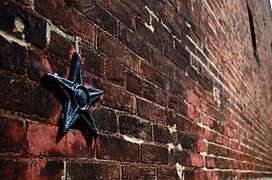 A star-shaped anchor plate in Soulard, St. Louis
A star-shaped anchor plate in Soulard, St. Louis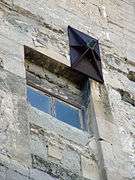 An anchor plate in the cloister of the Church of St. Trophime, Arles (France)
An anchor plate in the cloister of the Church of St. Trophime, Arles (France)
See also
- Barnstar, a purely decorative device
- Tie (cavity wall), used internally within cavity walls
References
- Gorse, Christopher; Johnston, David; Pritchard, Martin (2013). Oxford Dictionary of Construction, Surveying and Civil Engineering. Oxford University Press. p. 20. ISBN 9780199534463.
- Bucher, Ward (1996). Dictionary of Building Preservation. Preservation Press. p. 576.
- Pattress plate example Archived 2009-07-26 at the Wayback Machine stainless-uk.co.uk
- Harris, Cyril M. (2000). Dictionary of Architecture and Construction, Third Edition. McGraw Hill. pp. 31–32. ISBN 0-07-135178-7.
- Kidder, Frank E. (1913). The Architect's and Builder's Handbook. John Wiley & Sons. p. 553.
- Pisani, Marco Andrea (October 1, 2016). "Theoretical approach to the evaluation of the load-carrying capacity of the tie rod anchor system in a masonry wall". Engineering Structures. 124: 85–95. arXiv:1804.08620. doi:10.1016/j.engstruct.2016.06.015.
- Shin, Jiuk; Kim, JunHee; Chang, Hak-Jong (January 1, 2016). "Anchor plate effect on the breakout capacity in tension for thin-walled concrete panels". Engineering Structures. 106: 147–153. doi:10.1016/j.engstruct.2015.10.028.
External links
